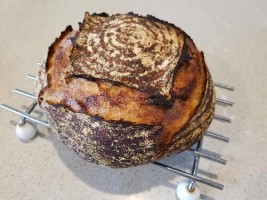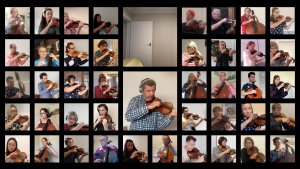Restoring a Waye of life
27.05.2020
Principal Piccolo Michael Waye has honed more than one craft during the 30 plus years he has spent with WASO, “My quirky talent away from Perth Concert Hall and music is not so hidden, especially when you look around our house. I enjoy furniture design and antique furniture restoration.”
Labelled a born tinkerer by his parents, Michael always enjoyed pulling things apart and reassembling them, “My earliest projects were at our family home in Sydney and, like all beginnings, were rather clumsy and rudimentary with my limitless enthusiasm but impoverished skill and equipment.”
Michael quickly realised the importance of taking note of the exact order in which things are taken apart, describing his most humbling experience as when he dismantled the family piano assuming that all of the keys were built alike, “I soon rather shamefacedly discovered the truth about piano keys each being a shape unto itself…my mother, was none too impressed with this artistically arranged pile of ebony and ivory on the floor. My parents took it in their stride and treated the incident as a “learning opportunity”; a repairer was brought in and nothing more said.”
Michael's curiosity around antique furniture started in his days as a boy chorister with the St Augustine’s Collegiate Choir, “Our school choir was reasonably famous, having even recorded an LP, as 12-year-olds, we thought we were rock stars! The choir’s notoriety meant that we had access to some of Sydney’s relatively ancient and awe-inspiring buildings and cathedrals.”
Having a choir mistress who was married to the organist of the historic St James’ Anglican Church in Sydney, meant the catholic choir were able to experience the beautiful building famously designed by convict architect Francis Greenway, “The furnishings there had the caress of over 100 years of polish and literally glowed in the candlelight of Evensong. That glow and a fascination for history struck a chord in my brain and I began to be curious as to just how the furniture had been made and how the artisans had created the glowing finish applied to the timber. Being pre-internet, the library was my first port of call where I discovered an Aladdin’s cave of books on architecture, art, furniture and most dangerous of all decorating magazines and DIY books.”
The old saying that one man’s trash is another man’s treasure rings true for Michael, “An aspect of my enjoyment of working with older pieces is seeing the value and potential in something that many people would simply relegate to the rubbish tip or burn as junk.” Some of his favourite projects are the so-called Frankenstein pieces he’s created from discarded and disparate pieces of furniture, “This style of creativity in the theatre is know as Teatro Provera or impoverished theatre utilising stuff that is readily available, discarded or borrowed. I must say that this is fundamentally how I furnished my homes as a student and as a young musician in WASO.”
When restoring old pieces, it’s not uncommon for Michael to discover the maker’s pencil marks, shipping and auction tags and the names of children, unbeknownst to their parents, written on the underside of tables and drawer bottoms. “I really love seeing and feeling the history of a piece of furniture. My curiosity is always sparked by the lives and history that the piece may have witnessed. I’m a bit of a romantic in that way, “day dreamer” and “too vivid an imagination” were always written on my school report cards.”
Whilst WASO has been unable to take the mainstage, Michael has spent his time on practice, outreach and teaching projects, “I’ve had some time to fit in the restoration of a Victorian mahogany sideboard circa 1860 from Liverpool in the UK and a Syrian Mother of Pearl and Tortoise shell inlay octagonal occasional table circa 1880.”
Although restoration is a time-consuming process, Michael loves the challenge, “Looking at the sideboard with more time on my hands lately led me to start from scratch and give the piece a complete facelift, repairing damaged structural elements and replacing mahogany veneers. Then came the task of re-polishing and three weeks later the end result speaks for itself.”
His favourite part of working on the occasional table, which had losses of nearly 90 percent of its mother of pearl inlay, was the process of recreating the star inlay and replacing the lost veneers.
The Syrian table has now gone home to its grateful owner and the sideboard is happily back in its position at Michael’s place.

